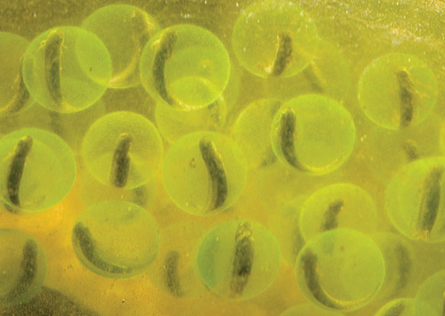Life
Salamander's algal partners, tool-using capuchins and more in this week's news
Embryos (and algae) on board
Spotted salamander embryos may rank as the first known vertebrates with full-fledged algal partners living inside their cells. Biologists had known that the embryos link up in some mutually beneficial way with an Oophilia algal species. Embryos develop more quickly and the algae grow better when the species entangle. Now, imaging and genetic analysis have detected algae hitchhiking in salamander egg capsules and actually living inside animal cells when the embryo starts developing, an international research team reports online April 4 in the Proceedings of the National Academy of Sciences. —Susan Milius

Capuchins get cracking
Wild capuchin monkeys pound open nuts with makeshift tools nearly every day, displaying skills that rival those of chimpanzees. During yearlong observations, male and female capuchins inhabiting a Brazilian jungle regularly brought carefully selected hammering stones and nuts to boulders and fallen trees that were used as anvils, primatologists will report in the Journal of Human Evolution. Male capuchins used tools more often than females, because males’ larger size enabled forceful pounding with stones that most female capuchins couldn’t lift over their heads, says a team led by Noemi Spagnoletti of Italy’s National Research Council in Rome. —Bruce Bower
A friendly infection
Say hello to the little friends of the sweet potato whitefly (Bemisia tabaci). Rickettsia bacteria infected populations of this pest in the U.S. Southwest like wildfire, an international team of researchers reports in the April 8 Science. In just six years, the bacteria went from infecting 1 percent of all whiteflies to 97 percent. The microorganisms’ success stems from their helpful attitude. Infected insects reached adulthood more often and churned out more progeny than their Rickettsia-free compatriots. But the bacteria aren’t Boy Scouts. They also persuaded unsuspecting bugs to make more daughters than sons, perhaps because the Rickettsia seem to spread best from mother to daughter. —Daniel Strain
Unneighborly flowers
Expanses of flowering oilseed rape may lure bumblebees away from wild plants. In field studies on 67 sites, a grassland primrose had 20 percent fewer seeds on average when, within a kilometer, planted oilseed rape burst into masses of bee-seductive flowers. Conservation planners may need to watch their neighborhoods for pollinator-sapping distractions, a team of researchers in Germany warns in an upcoming Proceedings of the Royal Society B. —Susan Milius






